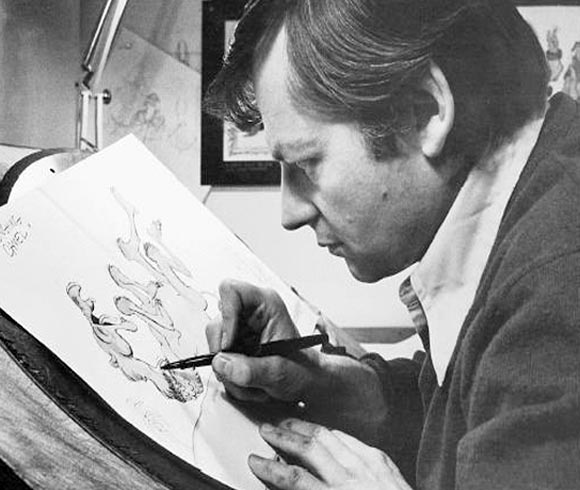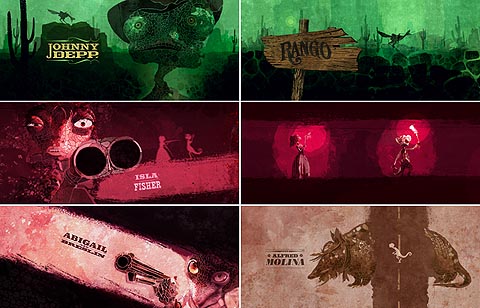"Prologue," he says, "is the only thing so far in my career that I've ever been really been pleased with."
The post Interview: Richard Williams Talks About His Oscar and BAFTA-Nominated Short ‘Prologue’ appeared first on Cartoon Brew.
Add a Comment
"Prologue," he says, "is the only thing so far in my career that I've ever been really been pleased with."
The post Interview: Richard Williams Talks About His Oscar and BAFTA-Nominated Short ‘Prologue’ appeared first on Cartoon Brew.
Add a Comment
Low-budget features and South American contenders are competing alongside Pixar this year.
The post 2016 Oscar Nominations: Animation Analysis appeared first on Cartoon Brew.
Add a CommentWilliams has worked for years to complete this hand-drawn six-minute short, animated entirely by himself.
Add a CommentThe legendary animator responsible for "Who Framed Roger Rabbit," "The Thief and the Cobbler," and so much more is on social media at least.
Add a Comment

The legendary Richard Williams, eighty years young, will appear in Los Angeles on Friday, October 4th, to celebrate the opening of a new exhibition devoted to his career, as well as take part in the Academy of Motion Picture Arts & Science’s annual Marc Davis Celebration of Animation. The lecture, entitled This Amazing Medium with Richard Williams, sounds like an event worth attending, even if not for the amazing bit casually tossed in at the end of the program description:
Williams will discuss the work that has inspired him and the people who have influenced him. Some of Williams’s favorite clips will be shown to illustrate the artistic and emotional range of this amazing medium, from the charm of Snow White and the Seven Dwarfs and the imagination of Fantasia to the stylized sophistication of Rooty Toot Toot and the subtlety of expression in Toy Story.
Williams will also enlighten audiences about his own work through clips from The Little Island, The Charge of the Light Brigade, A Christmas Carol, The Return of the Pink Panther, Who Framed Roger Rabbit, Circus Drawings and the first theatrical trailer for The Thief and the Cobbler, as well as a preview of his work-in-progress, Prologue.
That’s right, audiences will finally get a glimpse of the secretive film project that Richard has been working on for years. In an interview earlier this year, Williams revealed that he had nearly finished a six-minute prologue to the untitled film project “so if I do drop dead we will still have something.”
Tickets to the lecture will go on sale September 3, and are $5 (general admission)/$3 (students and Academy members). The lecture begins at 7:30pm at the Samuel Goldwyn Theater (8949 Wilshire Blvd, Beverly Hills, CA 90211).
As mentioned above, the Academy will also open a new gallery exhibition on the same night called “Richard Williams: Master of Animation”. The description sounds swell:
Add a CommentTake an exciting visual tour through Richard Williams’s career and experience his master class approach to the art of animation through this dynamic exhibition. Twelve unique zones, accompanied by matching chapters from Richard Williams’s new iPad App, show aspiring animators and pros alike how to direct animation and how Williams approaches character movement, dialogue, animal action and more. On view through December 22, 2013, Tuesday through Friday, 10 a.m. to 5 p.m. and weekends noon to 6 p.m.

In case you were curious, the end titles of Rango were produced by Venice, California-based Prologue, the studio helmed by title designer Kyle Cooper. Watch the titles HERE.
Cartoon Brew: Leading the Animation Conversation |
Permalink |
3 comments |
Post tags: Kyle Cooper, Prologue, Rango
 Marcus Zusak’s The Book Thief is a brilliant book on so many levels I don’t even know where to begin. I loved the book, but I hated the prologue. Let’s take a look for a minute:
Marcus Zusak’s The Book Thief is a brilliant book on so many levels I don’t even know where to begin. I loved the book, but I hated the prologue. Let’s take a look for a minute:
Question:
HI Martha!
I've been reading all the information available on Flashback and why it may not be the recommended route to begin a novel. Then I suddenly realized, by golly, this isn't a flashback, it's a prologue! My story starts back in history to provide a backdrop for the current story. My question ... how to you plot a prologue when it's the first "scene" in your book? Is it a chapter unto itself called Prologue? Can it be scene 1 in Chapter 1?
Thanks so very much!
Writing in North Carolina,
Nancy
Answer:
Dear Nancy,
The Prologue is a chapter unto itself, comes first, and is generally very short -- 2 to 3 pages. Chapter One follows the Prologue.
Or, you could make it scene 1 in Chapter 1.
The pros of one are the cons of the other, and visa versa.
For instance, readers sometimes ignore the Prologue. Changes in time right off the bat can confuse readers.
Best way to plot this first "scene", be it the Prologue or Chapter One is to make sure the scene introduces one or more of the three major plot lines -- dramatic action, character emotional development, or most likely, provide thematic significance and foreshadow what is to come.
I'll put out a request to some of my writer friends for more input and their take on the issue.
Hope this helps.
Great good luck with your project. Let me know how it goes.
Sincerely,
Martha
Is the right to free speech absolute? Does art need to be "fair and balanced"?
I've spent hours discussing these questions since my column on the cancellation -- or postponement, depending on who you talk to -- of the play "Voices in Conflict" at Wilton High School.
The most interesting yet disturbing conversation was via e-mail with 1st Lt. Zach Alessi-Friedlander, of the family whose protests managed to get the play canceled/postponed, who is currently serving in Iraq.
Lt. Alessi-Friedlander's position can be summed up by this, from his most recent e-mail to me: "High-school students are mostly under the age of 18 -- i.e. the age at which the government has determined that they are able to serve in the military and to vote in formal elections ... Prior to the age of 18, high-school-aged students are relieved of the responsibility of participating in our civic processes so that they may cultivate the critical thinking skills necessary to make these types of important decisions. You said in your response that Ms. Dickinson's ... students were intending to stimulate discussion and therefore are not required to do thesis work. I would counter this contention by saying that if these students want to take on a serious subject, then they must be prepared to do the serious work necessary not only to stimulate but to frame and develop a serious discourse."
I find his point of view problematic for many reasons. It's been many moons since I got my degree in politics, but I don't remember the Constitution limiting the right of free speech to those of voting age. But more than that, this script was written for a drama class, not for history, social studies or the debate club. A work of artistic expression shouldn't be expected to "frame and develop a serious discourse." It can, however, provide a vehicle through which serious discourse can take place. Art is meant to stimulate thoughts, emotions, beliefs or ideas. As an author, I'd argue that it is only able to do so by taking a stand.
Lt. Alessi-Friedlander feels the "pro-military service" point of view should be experienced by impressionable under-18s to counteract the arguably negative portrayal in "Voices in Conflict." But by allowing armed forces recruiters to set up shop in the school cafeteria, Principal Timothy Canty ensured that the military has a voice at Wilton High School. I find it extremely disturbing that it's fine for students to be exposed by on-campus recruiters to a one-sided portrayal of life in the service (do you think the soldiers currently serving in Iraq were told: "And by the way, we might just extend your tour of duty by five months while you're over there"?) but unacceptable for a drama class to present a play that explores other points of view on the conflict unless they do detailed study of the Middle East situation.
Lt. Alessi-Friedlander and I agree on one thing: "that freedom of speech is a privilege and a right; it is an extraordinary tool for shaping our nation's present and future." However, here's where we part ways: "In an abstract intellectual sense, the principal of free speech is absolute. However, in a practical sense, we must be willing to do the hard thinking and work necessary for free speech's most effective application."
I don't believe that free speech is absolute only in an "abstract intellectual sense," and that we are only guaranteed that right if we are willing to pursue with intellectual rigor every topic we wish to discuss in the public domain. The blessing (and yes, sometimes curse) of our Constitution is that any nut job has the right to speak out. Take Ann Coulter, for example.
I do agree with Lt. Alessi-Friedlander that, "We must, as a country, work harder to make the public discourse more serious -- and this starts with how we train the younger generation in school."
But here's where I think both Principal Canty and the Alessi-Friedlander family have got it wrong.
The Socratic Method is the oldest technique of fostering critical thinking, in which a teacher does not give information directly but rather asks a series of questions, continually challenging students' assumptions and logic, with the result that the class attains knowledge by answering the questions and, often as a result, deeper awareness of the limits of knowledge.
Why not present the play and then lead discussions using the Socratic Method? Surely a lesson in expression and critical discussion is better than one in suppression and intolerance?